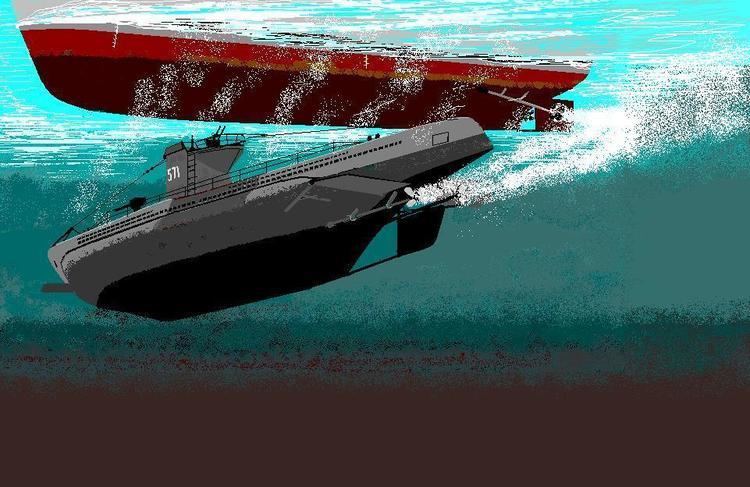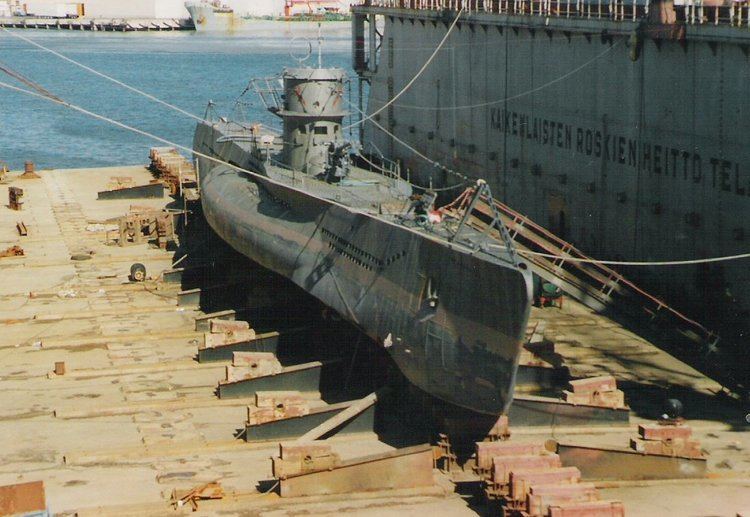Laid down 8 June 1940 Length 67 m Launched 4 April 1941 Draft 4.74 m Commissioned 22 May 1941 | Ordered 24 October 1939 Construction started 8 June 1940 Beam 6.18 m Builder Blohm + Voss | |
 | ||
Fate Sunk west of Ireland, 28 January 1944. 52 dead (all hands lost). | ||
German submarine U-571 was a Type VIIC U-boat built for the Nazi Germany's Kriegsmarine for service during World War II. U-571 conducted eleven war patrols, sinking seven ships totalling 47,169 gross register tons (GRT), and damaging one other, which displaced 11,394 tons. On 28 January 1944 she was attacked by an Australian-crewed Sunderland aircraft from No. 461 Squadron RAAF west of Ireland and was destroyed by depth charges. All hands were lost.
Contents

The fictional 2000 U.S. war film U-571 has no relation to this U-boat, but is very loosely based on the British capture of U-110 and her Enigma and cipher keys.

Design

German Type VIIC submarines were preceded by the shorter Type VIIB submarines. U-571 had a displacement of 769 tonnes (757 long tons) when at the surface and 871 tonnes (857 long tons) while submerged. She had a total length of 67.10 m (220 ft 2 in), a pressure hull length of 50.50 m (165 ft 8 in), a beam of 6.20 m (20 ft 4 in), a height of 9.60 m (31 ft 6 in), and a draught of 4.74 m (15 ft 7 in). The submarine was powered by two Germaniawerft F46 four-stroke, six-cylinder supercharged diesel engines producing a total of 2,800 to 3,200 metric horsepower (2,060 to 2,350 kW; 2,760 to 3,160 shp) for use while surfaced, two Brown, Boveri & Cie GG UB 720/8 double-acting electric motors producing a total of 750 metric horsepower (550 kW; 740 shp) for use while submerged. She had two shafts and two 1.23 m (4 ft) propellers. The boat was capable of operating at depths of up to 230 metres (750 ft).

The submarine had a maximum surface speed of 17.7 knots (32.8 km/h; 20.4 mph) and a maximum submerged speed of 7.6 knots (14.1 km/h; 8.7 mph). When submerged, the boat could operate for 80 nautical miles (150 km; 92 mi) at 4 knots (7.4 km/h; 4.6 mph); when surfaced, she could travel 8,500 nautical miles (15,700 km; 9,800 mi) at 10 knots (19 km/h; 12 mph). U-571 was fitted with five 53.3 cm (21 in) torpedo tubes (four fitted at the bow and one at the stern), fourteen torpedoes, one 8.8 cm (3.46 in) SK C/35 naval gun, 220 rounds, and an anti-aircraft gun. The boat had a complement of between forty-four and sixty.
Service history

Her keel was laid down 8 June 1940 by Blohm & Voss of Hamburg. She was commissioned 22 May 1941 with Kapitänleutnant Helmut Möhlmann in command. Under his command U-571 had nine successful patrols in the Arctic and in the North and Central Atlantic. In August and September 1941, U-571 operated against Allied and Soviet forces, sinking the Soviet passenger vessel Marija Uljanova on 26 August.

In 1942, U-571 operated off the east coast of the United States, sinking the British freighter Hertford on 29 March, the Norwegian tanker M/T Koll on 6 April off Cape Hatteras, and the American freighter Margaret on April 14 after the ship left San Juan, Puerto Rico. Although U-571’s log mentions that some of the 8 officers and 21 men managed to get into a lifeboat and onto rafts, none of Margaret’s crew were ever seen again. In July 1942 the submarine operated in the Caribbean and torpedoed four ships; the British freighter Umtata on 7 July, the American tanker, SS J. A. Moffet on 8 July, the Honduran freighter Nicholas Cuneo on 9 July and on 15 July the American tanker, SS Pennsylvania Sun.
The whole crew of J. A. Moffet (35 merchant marine and 5 Naval Armed Guard) abandoned ship into two lifeboats and three rafts, except for the master who was killed. The United States Coast Guard vessels Mary Jean and Southbound picked up the 39 survivors and brought them to Florida. When SS Pennsylvania Sun was torpedoed, two of the merchant crew died in the resulting explosion, but the rest of the 40 merchant marine crew and the 17 members of the Naval Armed Guard survived after being rescued by USS Dahlgren. Pennsylvania Sun was later salvaged and returned to service, while the other three ships attacked in July were sunk.
On 22 March 1943, U-571 was attacked by an aircraft in the North Atlantic and was damaged and had to return to base. In April 1943, Möhlmann claimed that he sank three additional ships but these could not be matched with records of Allied losses. On 22 April 1943, she had to return to base because the commander was badly injured in an accident on the conning tower. On 2 May 1943, Möhlmann was relieved by Oberleutnant zur See Gustav Lüssow. U-571 patrolled off the west coast of Africa in July before returning to base on 1 September. Between September and December, U-571 was probably being overhauled in a drydock as no mention of the boat for that time period appears in war diary kept by the German Commander in Chief, Submarines, Admiral Karl Dönitz.
On 18 January 1944, Lüssow reported to his submarine command that he attacked and sank an unknown destroyer; however, this could not be verified to any known Allied losses during World War II.
Fate
On 28 January 1944 she was attacked by an Australian-crewed Sunderland aircraft from No. 461 Squadron RAAF west of Ireland and was destroyed by depth charges. The aircraft's captain, Flight Lieutenant R. D. Lucas, reported that most of the crew successfully abandoned ship, but soon died from hypothermia. U-571 sank with all hands — 52 dead — at 52°41′N 14°27′W. She had not suffered any casualties to her crew during her career until then. The plane, EK577 (callsign "D for Dog"), was crewed partly by Royal Air Force (RAF) personnel and was based at RAF Pembroke Dock, in Wales. The crew was Lucas, Sergeant (Sgt) J. R. Brannan (RAF, a Canadian), Flight Sergeant (F/Sgt) W. J. Darcey, Sgt D. Musson (RAF), F/Sgt S. T. Burnett, Sgt D. McWalker (RAF), Flying Officer (F/O) H. D. Roberts, F/Sgt G. H. Simmonds (RAF), F/O R. H. Prentice, and F/Sgt C. D. Bremner.
Wolfpacks
U-571 took part in 14 wolfpacks, namely.
